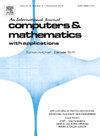Phase field lattice Boltzmann method for liquid-gas flows in complex geometries with efficient and consistent wetting boundary treatment
IF 2.9
2区 数学
Q1 MATHEMATICS, APPLIED
引用次数: 0
Abstract
This study investigates the application of wetting boundary conditions for modelling flows in complex curved geometries, such as rough fractures. It implements and analyses two common variants of the wetting boundary condition within the three-dimensional (3D) phase field lattice Boltzmann method. It provides a straightforward and novel extension of the geometrical approach to curved three-dimensional surfaces. It additionally implements surface-energy approach. A novel interpolation-based mitigation of the staircase approximation for curved boundaries is then developed and consistently applied to both wetting boundary conditions. The objectives of simplicity and parallel compute efficiency in implementation are emphasised. Through detailed validation on a series of 3D benchmark cases involving curved surfaces, such as droplet spread on a sphere, capillary intrusion, and droplet impact on a sphere, the behaviour of the wetting boundary conditions are validated and the differences between methods are highlighted. To demonstrate the applicability of the proposed approach in complex geometries with varying surface curvatures, two-phase flow through a synthetic rough fracture is presented. The suitability of the methods for complex simulations is also verified by comparing the computational performance between all investigated methods using this fracture flow test case. The present work thus contributes to the field of multiphase flow modelling with the lattice Boltzmann method in realistic applications where addressing the impact of complex geometries is essential.
复杂几何液气流动的相场晶格玻尔兹曼方法与高效一致的润湿边界处理
本研究探讨了湿润边界条件在模拟复杂弯曲几何流动中的应用,如粗糙裂缝。实现并分析了三维相场晶格玻尔兹曼方法中两种常见的润湿边界条件。它提供了一个简单的和新颖的几何方法的扩展到弯曲的三维表面。它还实现了表面能法。然后开发了一种新的基于插值的曲线边界阶梯近似缓解方法,并一致地应用于两种湿润边界条件。强调了实现的简单性和并行计算效率。通过一系列涉及曲面的三维基准案例(如液滴在球体上的扩散、毛细侵入和液滴在球体上的撞击)的详细验证,验证了润湿边界条件的行为,并突出了方法之间的差异。为了证明所提出的方法在具有不同表面曲率的复杂几何形状中的适用性,给出了通过合成粗裂缝的两相流。通过对比各研究方法的计算性能,验证了该方法在复杂模拟中的适用性。因此,目前的工作有助于多相流建模领域与晶格玻尔兹曼方法在现实应用中解决复杂几何形状的影响是必不可少的。
本文章由计算机程序翻译,如有差异,请以英文原文为准。
求助全文
约1分钟内获得全文
求助全文
来源期刊

Computers & Mathematics with Applications
工程技术-计算机:跨学科应用
CiteScore
5.10
自引率
10.30%
发文量
396
审稿时长
9.9 weeks
期刊介绍:
Computers & Mathematics with Applications provides a medium of exchange for those engaged in fields contributing to building successful simulations for science and engineering using Partial Differential Equations (PDEs).
 求助内容:
求助内容: 应助结果提醒方式:
应助结果提醒方式:


